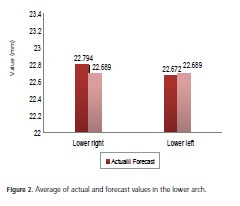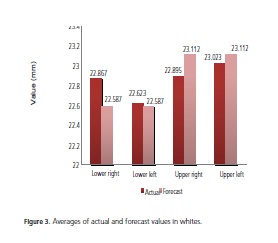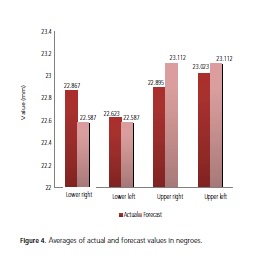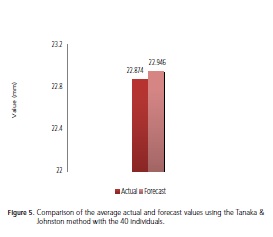Serviços Personalizados
Artigo
Links relacionados
Compartilhar
RGO.Revista Gaúcha de Odontologia (Online)
versão On-line ISSN 1981-8637
RGO, Rev. gaúch. odontol. (Online) vol.61 no.1 Porto Alegre Jan./Mar. 2013
ORIGINAL / ORIGINAL
Examination of Tanaka & Johnston's prediction regarding mesiodistal measurements of unerupted canines and premolars
Averiguação da predição de Tanaka & Johnston em relação ás medidas mesiodistais de caninos e pré- molares não irrompidos
Isis Rodrigues Menezes dos SANTOSI; Walter Pinheiro NORONHAI
I Universidade Federal de Sergipe, Faculdade de Odontologia
ABSTRACT
Objective
To evaluate the method proposed by Tanaka & Johnston with the prediction of the mesiodistal diameter of unerupted canines and premolars in the Brazilian population, in the Department of Dentistry at the Federal University of Sergipe in Aracaju.
Methods
The maxillary and mandibular mesiodistal diameters of the permanent incisors, canines and premolars were measured directly in the oral cavity with the help of a compass and then calibrated using a digital electronic caliper on a sample of 40 individuals, 20 females (10 white race and 10 black race) and 20 males (10 white race and 10 black race) aged between 14 and 23. The results obtained with the application of the Tanaka & Johnston formulae were compared with the actual values through statistical tests.
Results
There was a greater variation between the actual and predicted values using the method of Tanaka & Johnston in females. The maxilla and black race also had a greater variation, but this variation was considered statistically insignificant.
Conclusion
Although the Tanaka & Johnston study had been conducted on a sample of European descendants, when used on the Brazilian population described, the method was effective for gender, race and age, giving us a level of reliability in the research study of 69.1%.
Indexing terms: Bicuspid. Cuspid. Mixed dentition. Orthodontics.
RESUMO
Objetivo
Avaliar o método preconizado por Tanaka & Johnston com a predição do diâmetro mésiodistal de caninos e pré-molares não-irrompidos na população brasileira no Departamento de Odontologia da Universidade Federal de Sergipe em Aracaju, Sergipe.
Métodos
Foram medidos os diâmetros mésiodistais dos incisivos, caninos e pré-molares superiores e inferiores permanentes diretamente na cavidade bucal com o auxílio de um compasso, e em seguida aferido por um paquímetro digital eletrônico numa amostra de 40 indivíduos, 20 do gênero feminino (10 brancos e 10 negros) e 20 masculinos (10 brancos e 10 negros) compreendidos entre 14 e 23 anos de idade. Através de testes estatísticos, foram comparados os resultados reais com os previstos pelo método de Tanaka & Johnston.
Resultados
Houve uma maior variação entre os valores reais e previstos pelo método de Tanaka & Johnston no gênero feminino. O arco superior e a raça negra obtiveram também uma maior variação, porém foi considerada estatisticamente insignificante.
Conclusão
Apesar de a pesquisa de Tanaka & Johnston ter sido realizado numa amostra de descendentes europeus, ao ser estudado o método na população brasileira descrita, o método foi eficiente para gênero, etnia e faixa etária, nos dando um nível de confiabilidade na pesquisa de 69,1%.
Termos de indexação: Dente pré-molar. Dente canino. Dentição mista. Ortodontia.
INTRODUCTION
A large number of cases of malocclusion originate during the mixed dentition period, usually resulting from dental crowding caused by the premature loss of deciduous teeth, the main culprit being caries. The role of the dental surgeon is to supervise and direct the development of an efficient, balanced masticatory apparatus from a morphological, esthetic and functional point of view1.
In 1933, Broussard mentioned that the deciduous teeth occupy defined positions and exercise specific functions. When lost prematurely, the adjacent teeth lean towards the areas of least resistance, causing the closure of spaces and the breaking of ideal contact, essential for the development of the bones, the support structures and the permanent teeth that will follow2.
Accordingly, maintaining the integrity of the dental crown is fundamental to the conservation of space in the arch for the eruption of the permanent tooth, and the carious process is the main culprit in the partial or total loss of dental structure3.
It is known that the best retainer of space is the tooth itself where, in harmony with the oral musculature, it carries out the functions of chewing, phonetics, swallowing and esthetics. The deciduous teeth are also responsible for stimulating the development of the upper jaw, they maintain the permanent tooth space, contain the antagonists in the occlusal plane as well as guiding the eruption of the permanent teeth1.
The use of analyses to determine discrepancies in molds is important for the professional to be able to plan the malocclusion treatment, opting for maintenance or recovery of the space, interproximal wear, serial extractions, functional orthopedic treatment or even verifying that there is no need for intervention. Inadequate or invalid results of the spatial analysis of the dental arch can lead to decisions to extract which cause a negative alteration in the patient's profile4.
The analysis of the dentition is a record of the utmost importance in cases of malocclusion, mainly in the lower arch where the management of the space is critical and its acquisition through the movement of posterior teeth towards the distal is very limited. The analysis cannot guarantee a definitive case diagnosis but it does direct the planning of space maintenance, of mild rehabilitation or even serial extractions5.
In 1924, Lyons examined 5,000 children in a study which aimed to describe the importance of early recognition of dental disorders in children. When these teeth are lostprematurely, a loss in growth stimulus occurs and can lead to bad eruption or the impaction of the succeeding tooth. He explained that in children between the ages of 5 and 12, where some form of malocclusion was observed, 65% were likely associated with premature tooth loss6.
Various methods have been proposed to evaluate the space present in the dental arch and the space required to accommodate and align the erupting permanent teeth7-8.
The specific prediction method proposed by Tanaka & Johnston in 1974 advocates the use of one-half of the sum of the mesiodistal diameter of the lower permanent incisors plus a predetermined value corresponding to 10.5 mm for the lower arch and 11 mm for the upper arch9. The specific prediction method proposed by Tanaka & Johnston has a number of advantages over other methods: fast application, easy to memorize, big time saving and it can be applied directly at the time of the first appointment. This method helps to predict the size of the canines and premolars and check if the space will be sufficient for their eruption9-11.
Based on the assumption that race is a contributing factor to the variability of the mesiodistal diameter of the permanent teeth and taking into consideration that the Tanaka & Johnston9 formulae were assembled on the basis of a sample of individuals of European descent, some authors have checked the effectiveness of the abovementioned method in different ethnic groups, as in the study by Ingervall & Lennartsson12 on Swedes, Frankel & Benz13 on black Americans, the study of Al-Khadra14 on the population of Saudi Arabia and Parra et al.15 on Colombians.
Thus the aim of the present study is to evaluate the method advocated by Tanaka & Johnston to predict the mesiodistal diameter of unerupted canines and premolars in the Brazilian population, in the municipality of Aracaju in the state of Sergipe.
METHODS
The present work is a research study approved by the Committee of Ethics in Research on Human Subjects at the Federal University of Sergipe, under protocol no. 0036.0.107.000-09, carried out in the day clinic of the Department of Dentistry at the Federal University of Sergipe, between July 2009 and April 2010.
For the performance of this study, 40 individuals of different races were selected out of a total sample of 200. In the study, only white and negro races were selected,the classification of race being suggested by Azevêdo16 in 1980, in which individuals are distributed as white, white mixed race, colored mixed race, dark mixed race and negro and is produced according to skin pigmentation, color and hair type and shape of lips and nose. All the measurements were carried out by the researcher.
The selected individuals comprised: 20 females (10 whites and 10 negroes) and 20 males (10 whites and 10 negroes), aged between 14 and 23. As the criterion for acceptance, the subjects had to have completely erupted permanent teeth, no apparent loss of dental substance through wear, no caries or proximal restorations and no dental alterations of shape or size, as this allows for the measurement of the actual mesiodistal distances of the clinical dental crowns. Moreover, they must not have been subjected to any orthodontic treatment as there are some techniques that advocate proximal tooth wear, which would have an adverse impact on the actual crown size.
The mesiodistal distances of the permanent upper and lower incisors, canines and premolars were measured directly in the oral cavity, with the aid of a bow divider manufactured by ICE (Instrumento Cirúrgico Esmeralda, Cajamar, Brazil), and then checked using a STAINLESS digital electronic pachymeter (Stainless Steel Construction, China) with a capacity of 0-150 mm, reading accuracy of 0.01mm and precision of approximately 0.02mm.
Once this was completed, the Tanaka & Johnston formula was applied using the sum of the mesiodistal diameters of the lower incisors and then comparing the sum of the canine and premolar mesiodistal distances.
The data obtained were subjected to descriptive analysis (median, average and standard deviation) with a level of significance of 5% and to the Student's t-test, and were submitted separately for statistical analysis using the application STATISTIX for Windows (version 7.0, 2000, Analytical Software, Inc.). Lastly the study's level of reliability was obtained.
RESULTS
For an analysis of the results, the actual values of erupted permanent canines and premolars were compared to the values predicted by the Tanaka & Johnston method, with a separate evaluation by sex, race and right and left sides in both dental arches.
The significance test carried out using the study results showed that these values were not significant (p>0.05), i.e. the measurement found using the Tanaka& Johnston formula differs from the Figures 3 and 4 make actual measurement, though this difference is not significant.
When comparing the averages for the male and female sexes, and relating these to the actual and forecast values obtained from the lower arch (LR and LL) and upper arch (UR and UL), the biggest difference in the male sex was obtained in the lower right arch with a difference of 0.413mm, while in the female sex the largest difference occurs in the upper left arch with a difference of 0.632mm. For the males, the averages of the actual values were always higher than the forecast averages, whereas the opposite occurred with females.
Analyzing the averages of the upper and lower arches, Figure 1 showed that there was a greater difference in the upper right arch of 0.092mm versus the upper left arch which was 0.281mm. In Figure 2, the difference was 0.105mm for the lower right arch and 0.017mm for the lower left arch.


Figures 3 and 4 make comparison comparison between races. In whites, the biggest difference between averages occurred in the lower right arch in which, when compared to the actual and forecast values, we can see a difference on average of 0.28mm. In negroes, on the other hand, the biggest difference between the averages was in the upper left arch, at 0.472 mm.


Figure 5 illustrates the comparison of the average actual values with the forecast values found via the Tanaka & Johnston formula. It can be seen that the average actual values found in the sample of 40 individuals were lower than the values obtained via the formula. The difference, however, confirms the lack of significance (less than 0.1mm).

DISCUSSION
The importance of the study on Brazilian individuals contributes to the veracity of the Tanaka& Johnston method in this population as the method they proposed was produced based on a sample of individuals of European descent.
As far as race is concerned, Frankel & Benz13 analyzed the diameters of the teeth of 80 black American children aged between 12 and 17 in order to compare the regression equations between Caucasians and negroes. They found a significant difference in the regression equation in the lower jaws of negro males when compared with the Tanaka & Johnston equation for Caucasians and the regression equation for negro females. Comparing the article by Frankel & Benz13 with the current article, we see in the study conducted in Aracaju (Sergipe state) that the biggest difference between actual and forecast values, using the Tanaka & Johnston method, was not greater than 0.5mm in negroes, which is a statistically insignificant value, thereby proving that the method is effective for the study of negroes in Brazil.
The task of limiting the age ranges in the sample was seen to be effective; Frankel & Benz13 and Al-Khadra14 limited the age range in their studies on the Tanaka& Johnston method, as this control is needed to prevent a number of discrepancies in the measurements based on the loss of dental substance through physiological wear and tear. The same studies also showed the importance of the choice of study subjects, by excluding individuals undergoing orthodontic treatment. Crosby & Alexander17, however, did include patients undergoing orthodontic treatment without interproximal wear or dental extractions. In the present study, the selection of the patients studied was of great relevance, as the choice of individuals in an intermediate age bracket and the exclusion of patients undergoing orthodontic treatment precludes possible alterations in the measurements.
Berthold18 evaluated 52 molds of Brazilian Caucasian patients of both sexes, aged between 17 and 22, and found a greater variation in measurements in the female sex. There was no statistically significant difference between actual and forecast values except for the lower arch in females, which had an actual value that was less than forecast which, according to the author, should not cause any clinical harm. In the present study, similarity was found with studies performed by Berthold18 and by Marchionni et al19, as the biggest difference occurred with females in the upper left arch, though this difference was not statistically significant, not altering therefore the effectiveness and efficiency of the proposed method. The differences in these studies may be related to the sample of the individuals studied; Berthold18 conducted his study on an Asian population which could result in alterations due to ethnicity. Marchionni et al.19, however, carried out a study using a Brazilian sample and there was no significant difference in the results.
Paula & Almeida20, based on inferior molds and 45 degree cephalometric x-rays of 45 patients, developed a comparative study between different prediction methods. They concluded that the study by Tanaka & Johnston has a tendency towards overestimation. Perhaps the methodology used in their study was not sufficiently effective for the aims of the study.
Using 100 plaster molds from patients in Saudi Arabia, Al-Khadra14 examined the applicability of the prediction methods (of Moyers and Tanaka & Johnston) for unerupted teeth, in a population different from that used in these methods. They found that the Saudi population has smaller teeth than the population used in the two prediction methods, therefore these methods did not produce such accurate results when used in the Saudi population.
Another fundamental question to be discussed is the comparison of the averages of the sum of the mesiodistal diameter of canines and premolars on the left side with the right side, in the same dental arch, which confers a more refined and specific, scientific support on the study of predicted size of dental components. Tanaka& Johnston did not consider the sides separately, suggesting a bilateral symmetry. The findings of the present study disagree with this affirmation as the measurements on the left side differ from those on the right.
In a study of 430 Thai youths, Jaroonthan& Godfrey21 demonstrated, by evaluating the efficacy of the Tanaka & Johnston method, that there was a significant difference between the results, giving a level of reliability of 50%. In the present study, no such difference was found. The method was satisfactory in terms of sex, race and age range. The averages of the actual and forecast values were compared via this method and this variance did not exceed 0.1mm, leaving us with a level of reliability in the study of 69.1%.
Checking the effectiveness of the Tanaka& Johnston method is very meticulous and demands of the researcher ability and precision of technique and the handling of the material. Despite the large anatomical variation that exists between individuals, and being aware of the wide-scale miscegenation in the country, it was possible to corroborate the Tanaka & Johnston method for the Brazilian population in the city of Aracaju, in the state of Sergipe.
CONCLUSION
Based on the results found and analyzed in this study, it may be concluded that there was a bigger variation in the values with the Tanaka & Johnston method for the female sex. As for the arches, the upper arch obtained a greater variation than the lower arch and, when studying the efficiency of the method between races, a satisfactory result was achieved, the variance being higher in the negro race.
Despite the Tanaka & Johnston method being conducted on a sample of European descendants, the method was considered to be efficient for the Brazilian population studied.
Collaborators
IRM SANTOS and WP NORONHA took part in all stages of the production of the article.
REFERENCES
1. Paixão RF, Fuziy A. Má oclusão: quando e como tratar. In: Cardoso RJA, Gonçalves EAN. Ortodontia: ortopedia funcional dos maxilares. 2ª ed. São Paulo: Artes Médicas; 2002. p. 27-49. [ Links ]
2. Broussard AC. Early extraction of deciduous and permanent teeth necessitating space retainers and restoration. Int J Orthod Dent Ch. 1933;19(1):968-73. [ Links ]
3. Lino AP. Ortodontia preventiva básica. São Paulo: Artes Médicas; 1990; p. 168. [ Links ]
4. Naik V, Durgekar, SG. Evaluation of Moyers mixed dentition analysis in school children. Indian J Dent Res. 2009;20(1):26-30. doi: 10.4103/0970-9290.49056. [ Links ]
5. Proffit WR, Bennett IC. Space maintenance, serial extraction, and the general practitioner. J Am Dent Assoc. 1967;74(3):411- 9. [ Links ]
6. Lyons DC. The importance of the early recognition of dental disorders in children. Dent Cosmos. 1924;66(1):535-8. [ Links ]
7. Battagel JM. The assessment of crowding without the need to record arch perimeter. Part I: arches with acceptable alignment. Br J Orthod. 1996;23(2):137-44. [ Links ]
8. Raberin M, Laumon B, Martin J, Brunner F. Dimensions and form of dental arches in subjects with normal occlusions. Am J Orthod Dentofacial Orthop. 1993;104(1):67-72. doi: 10.1016/0889-
5406(93)70029-N.
9. Tanaka MM, Johnston LE. The prediction of the size of unerupted canines and premolars in a contemporary orthodontic population. J Am Dent Assoc. 1974;88(4):798-801. [ Links ]
10. Ferreira FV. Ortodontia: diagnóstico e planejamento clínico. São Paulo: Artes Médicas; 1996. [ Links ]
11. Moyers RE. Ortodontia. 4ª ed. Rio de Janeiro: Guanabara-Koogan; 1991. [ Links ]
12. Ingervall B, Lennartsson B. Prediction of breadth of permanent canines and premolars in the mixed dentition. Angle Orthod. 1978;48(1):62-9. [ Links ]
13. Frankel HH, Benz EM. Mixed dentition analysis for black Americans. Pediatr. Dent. 1986;8(3):226-30. [ Links ]
14. Al-Khadra BH. Prediction of the size of unerupted canines and premolars in a Saudi Arab population. Am J Orthod Dentofacial Orthop. 1993;104(4):369-72. [ Links ]
15. Parra MI, Pardo MA, Yezioro S. Predicción del tamaño mesiodistal de los caninos permanentes y premolares no erupcionados en una muestra de niños colombianos. In: Primer Encuentro Latinoamericano de Investigación en Ortodoncia, Catagena. 1998;1(1):48-57. [ Links ]
16. Azevêdo ES. Subgroup studies of black admixture within a mixed population of Bahia, Brazil. Ann Hum Genet. 1980; 44(55): 55- 60. doi: 10.1111/j.1469-1809.1980.tb00945.x. [ Links ]
17. Crosby DR, Alexander CG. The occurrence of tooth size discrepancies among different malocclusion groups. Am J Orthod Dentofacial Orthop. 1989;95(6):457-61. doi: 10.1016/0889- 5406(89)90408-3. [ Links ]
18. Berthold TB. Tanaka/Johnston: um método simplificado e efetivo para a predição de tamanho de dentes permanentes não erupcionados. Rev Fac Odontol Porto Alegre. 1993;34(1):28-31. [ Links ]
19. Marchionni VMT, Silva MCA, Araujo TC, Reis SRA. Avaliação da efetividade do método de Tanaka-Johnston para a predição do diâmetro mésio-distal de caninos e pré-molares não-irrompidos. Pesqui Odontol Bras. 2001;15(1):35-40. doi: 10.1590/S1517-74912001000100007. [ Links ]
20. Paula S, Almeida MA. Análise comparativa entre os métodos de predição do diâmetro mésio-distal de caninos e pré-molares não erupcionados. Rev Bras Odontol. 1987;44(1):16-23. [ Links ]
21. Jaroontham J, Godfrey K. Mixed dentition space analysis in a Thai population. Eur J Orthod. 2000;22(2):127-34. [ Links ]
 Correspondence to:
Correspondence to:
IRM SANTOS
Av. Marechal Rondon, s/n., Jardim Rosa Elze, 49100-000, São Cristóvão, Sergipe, Brasil
e-mail: isisrmsantos@yahoo.com.br
Received on: 8/5/2010
Final version resubmitted on: 8/10/2010
Approved on: 5/9/2011













